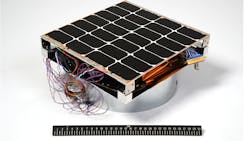Humanity's demand for sources of energy is growing, even if those sources are from outer space. As the U.S. Naval Research Laboratory (NRL) has demonstrated for over a year with its Photovoltaic Radio-Frequency Antenna Module (PRAM) experiment, solar energy captured in space may serve as a practical source for terrestrial applications on Earth. The PRAM energy-capturing device (see the figure) was launched aboard the U.S. Air Force X-37B Orbital Test Vehicle last May 17, 2020.
The PRAM experiment is evaluating components for what may be a power-satellite network to capture energy from space and transmit it anywhere on Earth. The PRAM team has been receiving data from the module on a regular basis, to better understand the mechanical and electrical performance requirements over time that will be needed for the long-term success of a power satellite network. “It’s been exhilarating getting to this point,” Paul Jaffe, Ph.D., PRAM principal investigator said. “While we would have liked the moment to arrive sooner, it’s great to feel that we’re making forward progress.”
Jaffe offered: “Seeing some of the effects of key differences between testing in space and on the ground has definitely been eye-opening. PRAM is successfully laying the foundation for the next iteration of experiments and demonstrations for space solar.”
Chris DePuma, PRAM program manager, explained: “The analysis to this point has shown that it has performed as well in orbit and even in some cases exceeded our pre-launch laboratory testing,” DePuma noted satisfaction from the first data package received from the X-37B Orbital Test Vehicle: “It confirmed all our hard work had paid off and PRAM was working in orbit, and delivering valuable data to advance space solar and power beaming research.”
Electromagnetic (EM) energy beams are used to transfer power from the PRAM unit to terrestrial receivers. If these experiments are successful, they will offer a means of collecting significant amounts of solar energy with a constellation of satellites and transferring the energy across free space via EM technology.
About the Author
Jack Browne
Technical Contributor
Jack Browne, Technical Contributor, has worked in technical publishing for over 30 years. He managed the content and production of three technical journals while at the American Institute of Physics, including Medical Physics and the Journal of Vacuum Science & Technology. He has been a Publisher and Editor for Penton Media, started the firm’s Wireless Symposium & Exhibition trade show in 1993, and currently serves as Technical Contributor for that company's Microwaves & RF magazine. Browne, who holds a BS in Mathematics from City College of New York and BA degrees in English and Philosophy from Fordham University, is a member of the IEEE.
